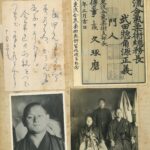For me, this is my very first website launch. The articles posted here are quoted from the old Takumakai newsletters and practice notebooks. I referred to many articles written by the masters who founded Takumakai, dating back to a time when they were much younger than my current age.
It may be a bit late to say now, but I express my gratitude to the masters who have left behind numerous valuable articles. When comparing several articles, you can discern the author by the rhythm and choice of words in the writing. Well, I say “discern,” but it’s a general sense, so there are still some that I can’t quite figure out.
Looking back, I think the Kata(forms) of Daitoryu we practice have a similar feeling. However, this metaphor might be challenging for outsiders to grasp. I hope to gradually delve into this intricate topic, and that’s why I’m attempting to express it in my own words through this essay.
In a rather broad classification, Takumakai preserves techniques taught by Master Ueshiba Morihei during the period when he went by the name Ueshiba Moritaka, as well as techniques passed down by Master Takeda Sokaku who can be often regarded as the practical founder. Additionally, we also transmit what can be commonly known as “Shoden waza” established by Sokaku’s son, Master Takeda Tokimune.
In a more general categorization, the first two are commonly referred to as “Soden waza” among our Takumakai members. The techniques passed by Master Takeda and Master Ueshiba in the early Showa Era were recorded and preserved by some employees of the Asahi Newspaper headquarters of Osaka, including Hisa Takuma.
Interestingly, there are techniques not recorded in these photographs but transmitted through other means, including verbal and hands-on instruction, these are also referred to as “Soden waza”. When it comes to discussions about this issue, I’m not entirely sure if there is a precise definition of Soden waza. It might simply be because I lack sufficient knowledge on this topic.
And, while this is purely my speculation, I suppose that techniques from Aikido, which were developed by Ueshiba Sensei in later years, have also been to some extent reintroduced and passed down in Takumakai. I sometimes feel that practitioners in the past interacted, influencing each other and somehow transmitting techniques.
In other words, it might convey a slightly refined impression, but we may be practicing the techniques of Soden waza, Shoden waza, and Aikido waza in an integrated and organic manner. However, I believe the essence of Takumakai has been more about having fun, practicing various techniques, and creating a lively and enjoyable atmosphere, rather than focusing on a sophisticated approach.
In the essays I am about to write,, I aim to organize the topics mentioned earlier. Though the writing may not be perfect, I hope it proves beneficial to those embarking on a path. Above all, it is for my own benefit as well.
To put it differently, I believe writing about such martial arts practices is beneficial because it encourages consistent training and maintaining a high level of awareness through continuous reflection.
Based on my actual training experience, my impression is that in “Soden Waza”, it’s more beneficial to perceive them not as a mere collection of individual skills, but rather as an inseparable series of methods or genres. By delving into the fundamental essence that permeates these techniques, I have a premonition that it could lead to a deeper understanding of Daitoryu.
However, since I haven’t reached such an extensive amount of training yet, the essays I will be writing from now on are nothing more than personal contemplation. They are informal musings and grumblings, so I hope you can view them as casual thoughts.
Takumakai Somucho
Akihiko Kobayashi

